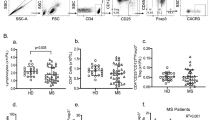Abstract
Triple-antibody flow cytometry was used to search for distinctive populations of peripheral blood lymphocyte immunophenotypes in multiple sclerosis (MS). Using monoclonal antibodies to the cell surface markers CD3, CD4, and CD8, T cell subsets were quantified on a cohort of 31 MS patients (not treated with corticosteroids for at least 6 months), 30 healthy donors, and 14 patients with other autoimmune diseases (also corticosteroid treatment-free for at least 6 months). Untreated MS patients displayed a significantly greater population of CD3+CD4+CD8+ circulating T cells than healthy donors (P = 0.023). Patients with other autoimmune diseases displayed mean populations of CD3+CD4+CD8+ cells greater than normal donors and less than MS, but not significantly different from either. An additional 45 MS patients who had received corticosteroid therapy within the previous 6 months were phenotyped. Treatment of symptomatic MS with corticosteroids was associated with a smaller population of circulating CD3+CD4+CD8+ cells. Some MS patients have significantly greater numbers of peripheral blood T lymphocytes simultaneously expressing CD3, CD4, and CD8 surface markers than healthy donors and this population of cells may be reduced by corticosteroids treatment. This triple positive phenotype may be a manifestation of a systemic immune abnormality in MS.
Similar content being viewed by others
References
Adams CWM:In Multiple Sclerosis, JF Hallpike, CWM Adams, WW Tourtellotte (eds). Baltimore, MD, Williams & Wilkins, 1983, pp 203–240
Trotter JL, Clifford DB, McInnis JE, Griffeth JC, Bruns KA, Perlmutter MS, Anderson CB, Collins KG, Banks G, Hicks BC: Correlation of immunological studies and disease progression in chronic progressive multiple sclerosis. Ann Neurol 25:172–178, 1989
Antel JP, Brown MB, Reder AT, Cashman N: Activated suppressor cell dysfunction in chronic progressive multiple sclerosis. J Immunol 137:137–141, 1986
Morimoto MD, Hafler DA, Weiner HL, Letvin NL, Hagan M, Daley J, Schlossman SF: Selective loss of the suppressor-inducer T-cell subset in progressive multiple sclerosis. Analysis with anti-2H4 monoclonal antibody. N Engl J Med 316:67–72, 1987
Tjernlund U, Cesaro P, Tournier E, Degos JD, Bach JF, Bach MA: T-cell subsets in multiple sclerosis: A comparative study between cell surface antigens and function. Clin Immunol Immunopathol 32:185–197, 1984
Kastrukoff LF, Oger J, Paty DW: Multiple sclerosis (MS): Correlation of peripheral blood lymphocyte (PBL) phenotypes and natural killer (NK) cell activity with disease activity assessed clinically and by MRI. Ann Neurol 20:164, 1986 (abstr)
Neighbor PA, Bloom BR: Absence of virus-induced lymphocyte suppression and interferon production in multiple sclerosis. Proc Natl Acad Sci USA 76:476–480, 1979
Chofflon M, Weiner HL, Morimoto C, Hafler DA: Loss of functional suppression is linked to decreases in circulating suppressor inducer (CD4+2HF+) T-cells in multiple sclerosis. Ann Neurol 24:185–191, 1988
Rose LM, Ginsberg AH, Rothstein TL, Ledbetter JA, Clark EA: Fluctuations of CD4+ T-cell subsets in remitting-relapsing multiple sclerosis. Ann Neurol 24:192–199, 1988
Paty DW, Kastrukoff L, Morgan N, Hiob L: Suppressor T-lymphocytes in multiple sclerosis: Analysis of patients with acute relapsing and chronic progressive disease. Ann Neurol 14:445–449, 1983
Poser CM, Paty DW, Scheinberg L, McDonald WI, Davis FA, Ebers GC, Johnson KP, Sibley WA, Silberberg DH, Tourtellotte WW: New diagnostic criteria for multiple sclerosis: Guidelines for research protocols. Ann Neurol 13:227–231, 1983
Landay A, Auer R, Duque R, Green W, Harvath L, Hurley A, Jackson A, Muirhead K, Nicholson J, Renner P: Clinical applications of flow cytometry: Quality assurance and immunophenotyping of peripheral blood lymphocytes. Document H42-P. Villanova, PA, NCCLS.
Mandy FF, Bergeron M, Recktenwald D, Izaguirre CA: A simultaneous three-color T-cell subsets analysis with singer laser flow cytometers using T-cell gating protocol: comparison with conventional two-color immunophenotyping method (submitted for publication)
Griffiths-Chu S, Patterson JA, Berger CL, Edelson RL, Chu AC: Characterization of immature T-cell subpopulations in neonatal blood. Blood 64:296–300, 1984
Foa R, Guibellino MC, Fiero MT, Lusso P, Fernando ML: Immature T lymphocytes in human cord blood identified by monoclonal antibodies: A model for the study of the differentiation pathway of T-cells in humans. Cell Immunol 89:194–201, 1984
Berrih S, Gaud C, Bach MA, LeBrigand H, Binet JP, Bach JF: Evaluation of T-cell subsets in myasthenia gravis using anti T-cell monoclonal antibodies. Clin Exp Immunol 45:1–8, 1981
Preffer FI, Colvin RB, Leary CP, Boyle LA, Tuazon TV, Lazarovits AI, Cosimi AB, Kurnick JT: Two-color flow-cytometry and functional analysis of lymphocytes cultured from human renal allografts: Identification of leu-2+3+subpopulation. J Immunol 137:2823–2830, 1986
Butcher EC, Weismann IL:In Fundamental Immunology, WE Paul (ed). New York, Raven Press, 1990, pp 117–137
Durelli L, Massazza U, Poccardi G, Ferrio MF, Cavallo R, Maggi G, Casadio C, Di Summa M, Bergamini L: Increased thymocyte differentiation in myasthenia gravis: A dual-color immunofluorescence phenotypic analysis. Ann Neurol 27:174–180, 1990
Paliard X, de Wasl Malefijt, de Vries J, Spits H: Interleukin-4 mediates CD8 induction on human CD4+ T-cell clones. Nature 335:642–644, 1988
Birnbaum G, Lackovic V, Kotilinek L, Tobolt D: A comparison of regulatory cells in spinal fluid and blood in patients with multiple sclerosis and other neurologic diseases. Neurology 40:1785–1790, 1990
Pette M, Fujita K, Kitze B, Whitaker JN, Albert E, Kappos L, Wekerle H: Myelin basic protein-specific T-lymphocyte lines from MS patients and healthy individuals. Neurology 40:1770–1776, 1990
Day MF, Mason DW: Loss of encephalitogenicity of myelin basic protein-specific T-cell line is associated with a phenotypic change but not with alteration in production of interleukin-2, gamma-interferon or tumor necrosis factor. J Neuroimmunol 30:53–59, 1990
Author information
Authors and Affiliations
Rights and permissions
About this article
Cite this article
Munschauer, F.E., Stewart, C., Jacobs, L. et al. Circulating CD3+ CD4+ CD+ T lymphocytes in multiple sclerosis. J Clin Immunol 13, 113–118 (1993). https://doi.org/10.1007/BF00919267
Accepted:
Issue Date:
DOI: https://doi.org/10.1007/BF00919267




